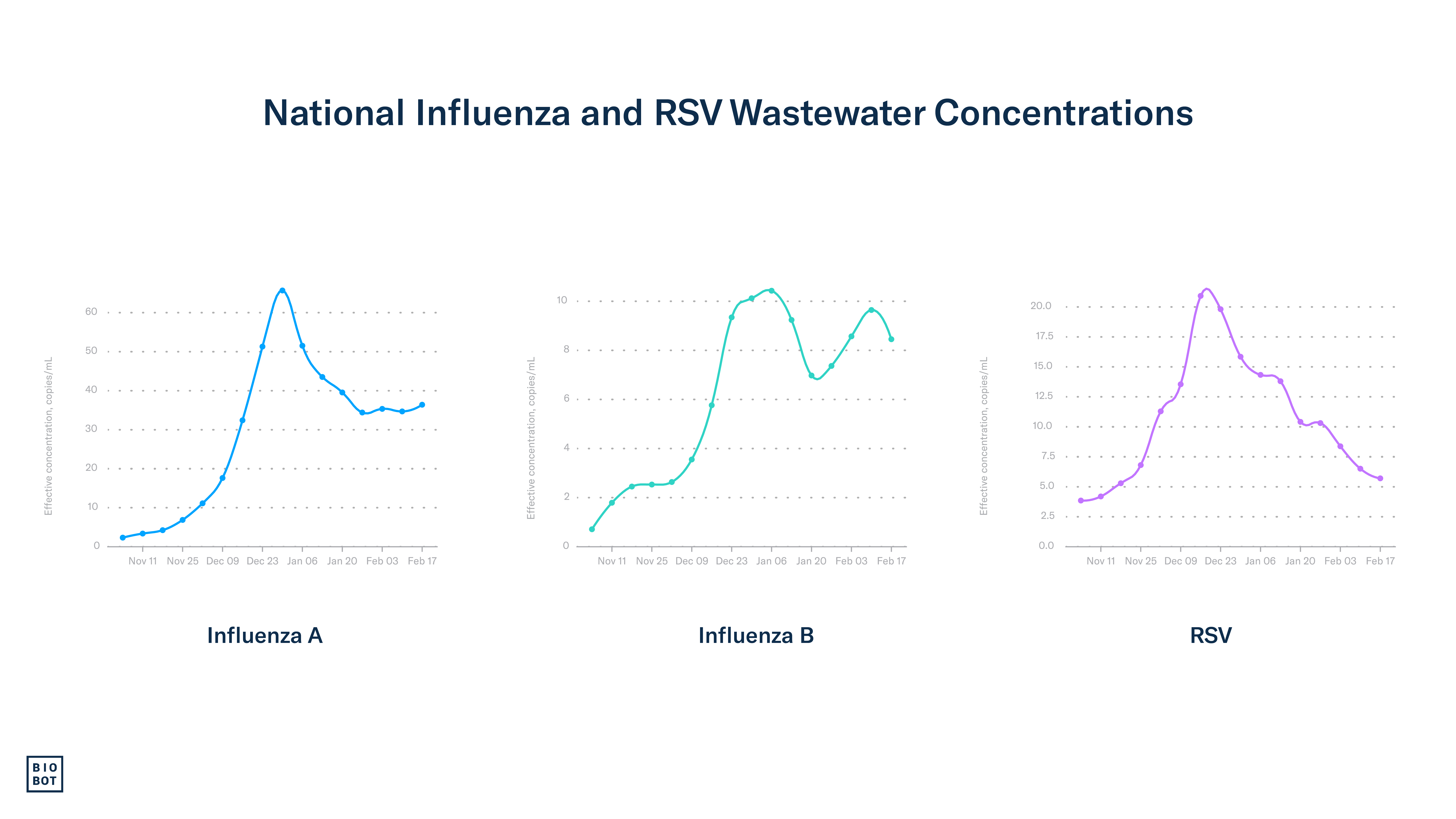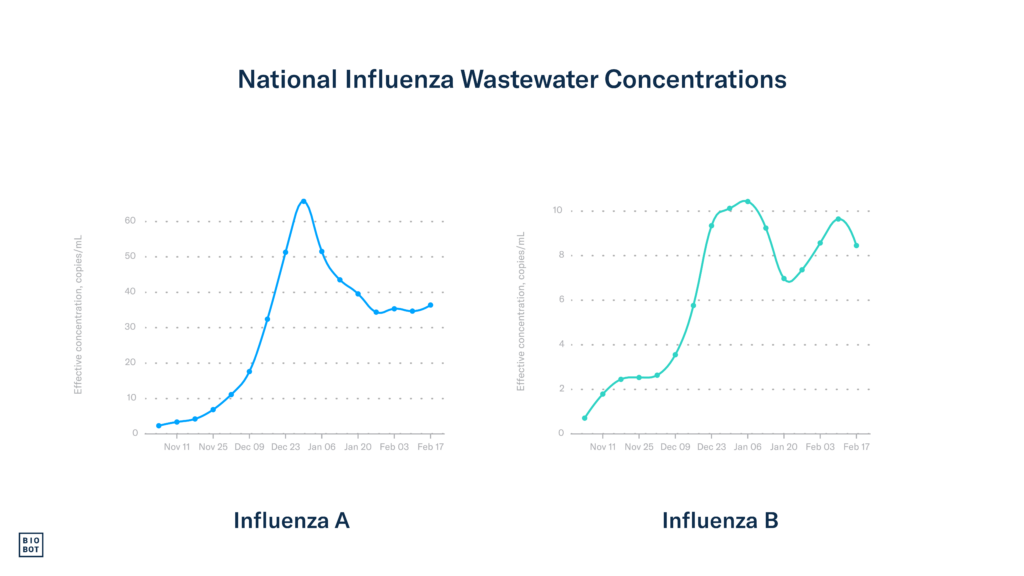At Biobot, we analyze wastewater across the country for various infectious disease pathogens....

Respiratory Virus Risk Reports
Comprehensive Insights for COVID-19, Influenza, and RSV
COVID-19, Influenza, and RSV Wastewater Monitoring in the U.S. | Week of February 19, 2024
This respiratory season, we are analyzing wastewater for the presence of respiratory syncytial virus (RSV) and influenza virus (types A and B). Together with COVID-19, these three pathogens are outsized contributors to our seasonal respiratory illness burden. In this data series, we’ll guide you through the wealth of data we’ve gathered from our Biobot Network of national sampling sites, aiming to shed light on emerging trends in respiratory virus activity and community viral load. Our goal is to equip you with information to make informed decisions, especially as we approach the holiday season and gather with family and friends.


Data Note: Samples are collected from participating locations and processed by our lab team on a rolling basis. Each point on the figure represents the weekly average concentration from Sunday – Saturday (corresponding to the MMWR week), aligned to that week’s Saturday.
Contributors

Marisa Donnelly, PhD
Public Health Partnerships Epidemiologist

Max Imakaev, PhD
Data Scientist
Previous Risk Reports
Summary: Week of 2/19/24
Data from Biobot’s national wastewater network and clinical disease monitoring show that while the RSV season appears to be coming to an end, influenza A and SARS-CoV-2 activity is persisting. National average wastewater concentrations for RSV declined during week 7, while concentrations for influenza A and SARS-CoV-2 increased. Some clinical metrics also signal that the disease burden due to respiratory illness remains high. It is looking like we will have at least a couple more weeks of elevated influenza and SARS-CoV-2 activity.
The Bottom Line: Respiratory illness activity is still high across most regions of the country, as is the risk of being exposed to these viruses. It is still an important time to reduce contact with others if you are feeling ill, consider wearing a mask in crowded environments, and keep up to date with vaccines and boosters. Taking these measures can help keep you and your loved ones healthy.
National Outlook
RSV
Nationally, RSV wastewater concentrations continue to decrease in week 7, going down by 12.3%, getting us one step closer to the end of the RSV season.
Clinical RSV metrics also continued to decline in week 6. As of February 10th, the percentage of PCR tests that are positive (test positivity) for RSV continues to decrease, going down from 5.5% the previous week to 4.8% currently. Hospitalization rates also continue to decline.

Influenza
Data through week 7 show that wastewater concentrations for influenza A, which is driving most clinical burden in the US, slightly increased, going up by 4.9%. In better news, influenza B concentrations began to decrease again, going down by 11.5% during week 7.
Unfortunately, the clinical burden due to influenza has paused its decline, with most clinical metrics remaining consistent compared to the previous week. For the second week in a row, there were around 11,000 hospitalizations due to influenza during week 6. The percentage of outpatient visits for flu-like symptoms – typical in flu, RSV, and COVID-19 patients – also did not substantially change, remaining around 4.5% in week 6. Once again, influenza test positivity also did not change, currently at 15.7% in week 6. While it’s unfortunate that this influenza season is lasting a bit longer, it’s not unheard of – both the 2018-2019 and 2019-2020 seasons had wide epi-curves that tended to fluctuate. A long flu season this year means that it’s still important to continue taking action to keep yourself and your loved ones healthy.

COVID-19
Wastewater data show that COVID-19 activity and community viral load increased in the previous week. As of February 17th (week 7), the national SARS-CoV-2 wastewater concentration average is 929 copies/mL.
Following a plateau in SARS-CoV-2 wastewater concentrations, COVID-19 hospitalization rates slightly increased during week 6, totalling 21,373 hospitalizations. Though in good news, the other major COVID-19 metrics declined. The national COVID-19 test positivity rate declined from 10% in week 5 to 9.3% in week 5. Deaths also declined by 6.9%, currently representing 2.7% of deaths in the US. These increases in wastewater concentrations paired with increases in hospitalizations suggest that we are not yet through this COVID-19 wave, and viral activity remains elevated.
Regional
The South
RSV: RSV wastewater concentrations remained consistent but low in the South during week 7, and are now around the level they were early on in the season in late October. RSV test positivity in the South has now dropped to levels seen at the very beginning of the season, currently 2.6%.
Influenza: Wastewater data through week 7 indicate consistent concentrations of influenza A and a strong decrease in concentrations of influenza B in the South. Following the plateau in influenza A wastewater concentrations, clinical data reflects an uptick in influenza activity. During week 6, most Southern states are again in the high or very high influenza-like illness categories, with a couple of Southern states experiencing moderate increases in influenza-like illness outpatient visits, including Tennessee, Kentucky, and West Virginia.
COVID-19: Wastewater concentrations increased again during week 7 in the South, currently at 896 copies/mL. Like we anticipated, following increases in wastewater concentrations during week 6, clinical data also showed an uptick in COVID-19 activity, with 5 Southern states experiencing an increase in hospitalizations due to COVID-19 during week 6 (Texas, Oklahoma, Arkansas, Louisiana, and Mississippi).
The Midwest
RSV: RSV wastewater concentrations continued to decrease in the Midwest during week 7. Test positivity during week 6 also declined, dropping to 6.7%, which suggests that RSV activity levels remain moderate.
Influenza: During week 7, influenza A wastewater concentrations began increasing again in the Midwest. Influenza B concentrations also increased slightly during week 7. Like the South, the Midwest is also experiencing a bit of a resurgence in influenza-associated clinical disease burden. The increases in influenza-like illness outpatient visits we started to see during week 5 continued to increase during week 6. South Dakota, Ohio, Michigan, and Nebraska experienced moderate increases in influenza-like illness outpatient visits, and half of Midwestern states are now in the high or very high influenza-like illness category.
COVID-19: The Midwest experienced another week of increases in SARS-CoV-2 concentrations during week 7, currently at 840 copies/mL. After observing a slight increase in wastewater concentrations in the previous week, we are starting to see clinical data respond. The improvements we’ve seen in clinical metrics in the Midwest have slowed down a bit, with a little over half of states reporting a slight increase in COVID-19-associated hospitalizations, and the others either slightly decreasing or staying consistent.
The Northeast
RSV: In the Northeast, RSV wastewater concentrations continued to decline during week 7. RSV test positivity also continued to decline during week 6, currently at 3.6%. Low wastewater concentrations and test positivity suggest that the Northeast is very close to the end of its RSV season.
Influenza: Like most other regions, influenza A concentrations increased slightly in the Northeast during week 7. Influenza B concentrations also continued to increase. During week 6, influenza-like illness outpatient visit rates in the Northeast did not change significantly, with most states in the low or moderate influenza-like illness categories. However, Maine and Pennsylvania did experience moderate increases in influenza-like illness outpatient visits. We’ll be keeping our eye on clinical metrics following the increases we’re seeing in wastewater concentrations.
COVID-19: SARS-CoV-2 wastewater concentrations remained mostly consistent in the Northeast during week 7, with current concentrations at 1,296 copies/mL. The Northwest also continues to show some good signs of continued decline in COVID-19 disease burden, with about half of states experiencing a decrease in COVID-19-associated hospitalizations during week 6 and the other half remaining mostly consistent compared to the previous week. We’ll keep an eye on this region to see if clinical data respond to this plateau in wastewater concentrations.
The West
RSV: After a long plateau, RSV wastewater concentrations slightly declined in the West during week 7. RSV test positivity in the West remained consistent from week 5 to week 6, currently at 5.7%. We will keep an eye on the West and hope clinical metrics begin dropping again.
Influenza: In the West, during week 7, wastewater concentrations for influenza A slightly increased but remained low, while concentrations of influenza B decreased. Clinical data through week 6 show that most states in the West experienced a decrease in influenza-like illness outpatient visit rates again; however, New Mexico, Colorado, and Wyoming remain in the high or very high categories.
COVID-19: In good news, SARS-CoV-2 wastewater concentrations declined in the West during week 7, currently at 423 copies/mL. In terms of clinical data, the West continues to move in the right direction as most Western states experienced a decrease in COVID-19 hospitalization rates during week 6. However, Wyoming and Montana experienced large increases in hospitalizations. We hope these states follow the downward trend seen in the rest of the West soon.


Footnotes:
Wastewater data from Biobot Analytics for RSV, influenza, and SARS-CoV-2 are through February 17, 2024 (MMWR week 7). Clinical data on testing, hospitalizations, and emergency department visits for RSV, influenza, and COVID-19 are from the Centers for Disease Control and Prevention. Updates to clinical data for RSV, influenza, and COVID-19 are through February 10, 2024 (MMWR week 6).






